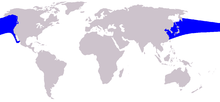Pacific white-sided dolphin
| Pacific white-sided dolphin | |
|---|---|
 |
|
 |
|
| Size compared to an average human | |
| Scientific classification | |
| Kingdom: | Animalia |
| Phylum: | Chordata |
| Class: | Mammalia |
| Order: | Artiodactyla |
| Infraorder: | Cetacea |
| Family: | Delphinidae |
| Genus: | Lagenorhynchus |
| Species: | L. obliquidens |
| Binomial name | |
|
Lagenorhynchus obliquidens (Gill, 1865) |
|
 |
|
| Pacific white-sided dolphin range | |
The Pacific white-sided dolphin (Lagenorhynchus obliquidens) is a very active dolphin found in the cool to temperate waters of the North Pacific Ocean.
The Pacific white-sided dolphin was named by Smithsonian mammalogist Theodore Nicholas Gill in 1865. It is morphologically similar to the dusky dolphin, which is found in the South Pacific. Genetic analysis by Frank Cipriano suggests the two species diverged about two million years ago.
Though both are traditionally placed in the genus Lagenorhynchus, molecular analyses indicate they are closer to dolphins of the genus Cephalorhynchus. The new genus Sagmatias has been proposed for these species.
The Pacific white-sided dolphin has three colors. The chin, throat and belly are creamy white. The beak, flippers, back, and dorsal fin are a dark gray. Light gray patches are seen on the sides and a further light gray stripe runs from above the eye to below the dorsal fin, where it thickens along the tail stock. A dark gray ring surrounds the eyes.
The species is an average-sized oceanic dolphin. Females weigh up to 150 kg (330 lb) and males 200 kg (440 lb) with males reaching 2.5 m (8.2 ft) and females 2.3 m (7.5 ft) in length. Pacific white-sided dolphins usually tend to be larger than dusky dolphins. Females reach maturity at seven years. From 1990 to 1991, a study conducted by Richard C. Ferrero and William A. Walker revealed the vast majority of Pacific white-sided dolphins that fell victim to the drift nets were between the ages of 8.3 to 11 when they sexually matured. The gestation period usually last for one year. Individuals are believed to live up 40 years or more.
The Pacific white-sided dolphin is extremely active and mixes with many of the other North Pacific cetacean species. It readily approaches boats and bow-rides. Large groups are common, averaging 90 individuals, with supergroups of more than 300. Prey includes mainly hake, anchovies, squid, herring, salmon, and cod.
...
Wikipedia

